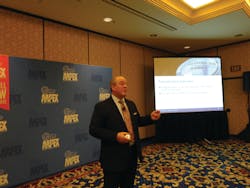David Portalatin, executive director at NPD Group, noted that the automotive aftermarket faces some challenges in 2014, but the industry is in a better position than many other sectors of the U.S. economy due to the importance that consumers are placing on automotive aftermarket service.
More importantly, he noted that consumers have overall changed the way they view older vehicles. Consumers are willing to invest more in maintenance and repair of older vehicles than they used to, which indicates the automotive aftermarket has an opportunity to grow. But for aftermarket companies to take advantage of this opportunity, they must recognize that consumers place more importance on quality and performance than on price.
Speaking to a standing-room-only audience at the Automotive Aftermarket Products Expo at the Sands Expo Center in Las Vegas, Portalatin reviewed the results of a survey for 2013 that he presented at last year’s expo and compared them to the actual performance. This marked the seventh consecutive year he presented an industry outlook at the annual AAPEX Show.
Early in the presentation, Portalatin conducted a live text poll of his listeners about their expectations for 2013, the answers of which he presented to the audience on a screen. Most attendees expected sales to increase between 2 percent and 4 percent in 2013 over 2012. Portalatin noted that this indicated the attendees were generally more optimistic than aftermarket companies in general, based on his company’s survey. Most aftermarket companies he surveyed expect 2013 revenues to post a 1.3 percent increase over 2012.
More importantly, aftermarket companies are more optimistic than most of the 21 industry sectors that NPD Group surveys.
However, even the most optimistic expectations for 2013 sales failed to match the projected 3.6 percent annual gain that NPD forecasted for 2013 last year. Portalatin discussed the reasons that sales fell short of expectations in 2013.
One reason is that average aftermarket retail prices were lower than expected. This was driven largely by a decline in miles driven. This was due in part to higher than expected fuel prices in 2013. Further contributing to the decline in miles driven was Hurricane Sandy, which ravaged the Northeast in late 2013.
Another reason was an overall decline in consumer confidence about the economy. This is a long-term trend. “I don’t think you’re going to see a big rebound in miles driven over the next few years,” he said.
Consumers will not be driving more in the near future due to higher fuel prices, minimal recovery in employment and a “generational shift.” The “generational shift” refers to the increasing number of baby boomers retiring who are not being replaced by the millennial generation.
Not only are the millennials not replacing baby boomers in number; they are less inclined to drive than the retiring generation. Millennials suffer a higher rate of unemployment and underemployment than other consumers; hence, they lack the means to drive as much.
“We need people to go back to work,” Portalatin said. “The millennials will never fully replace the mileage the boomers are leaving behind.”
In addition, the average price per unit of aftermarket product sold has not increased as much as NPD had expected. He credited this to excessive discounting. “Everything’s on sale all the time, everywhere,” he said. In the last year, aftermarket prices have increased by 4 percent on average, compared to the 10 percent NPD had forecasted.
Looking to 2014, Portalatin said the outlook is a bit less dismal. He said consumer spending is driven by certain factors: automotive spending is a priority for consumers. They don’t view automotive as a discretionary expenditure. “It’s something that they have to do,” he said.
He noted consumers spend about 10 percent of their available funds on their vehicles, making automotive the third highest expenditure after food and fuel. “You guys are at the top of the list,” he said.
Tempering this positive trend is the fact that consumers still are in cost cutting mode, he noted. He said 22 percent plan to spend less on vehicles in 2014 while only 11 percent expect to spend more.
A major consideration that weighs favorably for the aftermarket is the fact that consumers are placing greater value on used cars in general. Portalatin said both new car sales and used car sales are expected to grow in 2014. About a quarter of consumers expect to buy a new or used in car in 2014, he said.
Noting that 2013 has seen an increase in new car sales, Portalatin said it is incorrect to infer that this means consumers are less inclined to spend money on older vehicles.
“The vast majority is driving the same care for the next 12 months,” He said.
More importantly, the “sweet spot” – the average age of vehicles that consumers are expected to invest in to maintain in good condition – continues to increase.
While the “sweet spot” represents an opportunity to do-it-yourself retailers as well as aftermarket service companies, Portalatin said the outlook is nonetheless good for both groups.
NPD surveys indicate that the average consumer expects to spend $645 on maintenance and repair in the next year. For cars 10 years old and older, that figure is $751.
“Consumers are spending on these cars,” he said.
Another important factor affecting the automotive aftermarket is the fact that consumers define value in terms other than price. “You have opportunities to create value in ways that other (industries) really don’t,” he said.
Consumers place more value on quality and performance than on price when it comes to cars, he said. “Quality carries a lot more importance than absolute price,” he said.
Portalatin conducted another text poll for his listeners about sales expectations for 2014. He found that most in the audience expect sales to increase between 2 percent and 4 percent, which he characterized as “optimistic but not exuberant.” This closely matched the expectations of aftermarket companies in general, which according to his survey predict a 2.3 percent increase in dollar sales in 2013.
During the question and answer session, Portalatin noted that the “sweet spot” has increased from the four-to-seven-year range to the seven-to-15-year range.
About the Author

